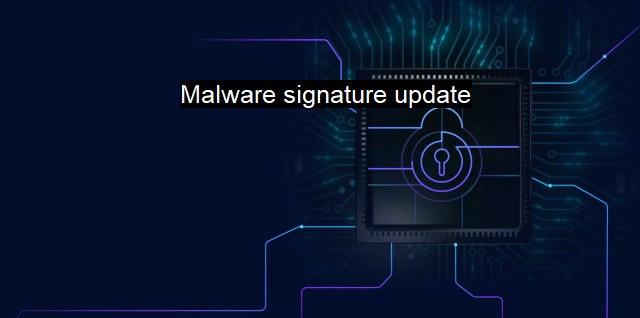What is Malware signature update?
Why Malware Signature Updates Are Crucial for Effective Cybersecurity: Understanding the Importance of Digital Fingerprinting and Regular Updates
A "malware signature update" has a critical role in maintaining the security of computer systems by ensuring improved protection against malicious software, widely known as malware. The primary task of a malware signature is to help identify types of malware during the scanning process, which enables the antivirus program to prevent, detect or remove malware from the infected system. To understand the importance of keeping these signatures up to date, one must first comprehend what malware and malware signatures are.Malware, succinctly put, is any software intentionally designed to cause damage to a computing system, server, network, or client. This definition encompasses all sorts of harmful programs such as viruses, worms, spyware, trojans, etc. Every year, millions of new strains of malware are discovered. Each of these harmful programs poses a unique threat to computer systems, with the potential for extensive monetary and data losses.
This is where malware signatures come into play. A malware signature is a unique series of bytes in malware code or an identifiable pattern of code, which help in identifying and classifying the type of malware after scanning it with an antivirus program. These malware signatures allow an antivirus software to discern the characteristics that distinguish one type of malware from another, even within a highly diversified malware family.
Malware signature updates form an integral part in counteracting these cyber threats. As cybercriminals continue to create new malware variants, different in structure or behavior from existing malware, these new threats will not be recognized by the existing database of malware signatures. Therefore, to maintain an effective defense against these evolving cyber threats, the database of known malware signatures needs to be consistently updated.
Updating of malware signatures can be viewed as analogous to updating a medical dictionary with the latest diseases and their treatments. If a medical professional is ignorant of the latest diseases, they would be unable to effectively diagnose and treat a patient, potentially leading to dire outcomes. Similarly, an outdated malware signature database may not be able to detect and eliminate novel strains of malware, resulting in potentially devastating cybersecurity breaches.
Malware signature updates are typically executed by the Antivirus or Antimalware vendors. The experts in these firms analyze new malware discovered in the wild, conduct malware reverse-engineering to understand their structure and behaviors, and then create signatures that uniquely identify these new threats. Once the new signatures are thoroughly tested, they are released as updates for their Antivirus software. The users can either opt for automatic updates or manually install these signature updates, depending on their software settings.
Frequent updates not only enable reliable detection of novel malware strains but also enhance the overall performance of the security tool as updates often come with software patches that fix bugs and improve system compatibility, increasing overall system efficiency.
a malware signature update plays a crucial role in cybersecurity. It ensures that the current protective measures against malware are sophisticated enough to promptly detect and prevent both old and emerging threats. Maintaining an updated malware signature database ensures that frontline detection and defense mechanisms stay one step ahead of cybercriminals and their constantly evolving strategies, thereby contributing significantly to the protection of valuable data and the overall integrity of digital systems in both organizational and personal spaces. Failing to factor in the evolutionary nature of malware by ignoring regular signature updates might create detrimental cybersecurity loopholes that cyber adversaries can exploit, leading to potentially disastrous consequences.

Malware signature update FAQs
What is a malware signature update?
A malware signature update is a term used in cybersecurity to describe when an antivirus or security provider adds new information to its database, which helps it to detect and stop new malware threats.Why is a malware signature update important?
Malware signature updates are important because new malware is constantly being created, and without updates, your antivirus system may not be able to detect the latest threats. Without updating your malware signatures, your system becomes vulnerable to attacks from new and emerging threats.How often should I update my malware signatures?
The frequency of malware signature updates varies between vendors, but it is recommended to update your antivirus software daily. Most antivirus programs are set up to automatically check for updates and apply them as needed, but you can also manually check for and apply updates as well.What happens if I don't update my malware signatures?
If you don't update your malware signatures, your antivirus program will not be able to detect new and emerging threats, leaving your system vulnerable to attack. This could result in the loss of critical data and personal information, as well as the potential for compromised system resources. Regular malware signature updates are an essential step in protecting your system against malicious attacks.| | A | | | B | | | C | | | D | | | E | | | F | | | G | | | H | | | I | | | J | | | K | | | L | | | M | |
| | N | | | O | | | P | | | Q | | | R | | | S | | | T | | | U | | | V | | | W | | | X | | | Y | | | Z | |
| | 1 | | | 2 | | | 3 | | | 4 | | | 7 | | | 8 | | |||||||